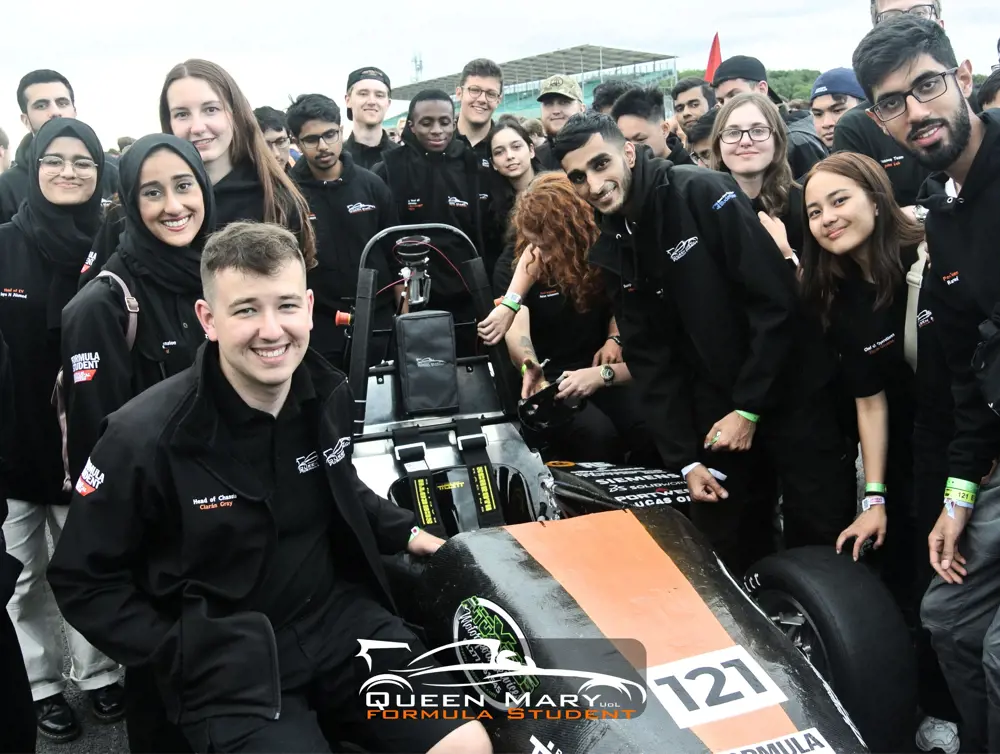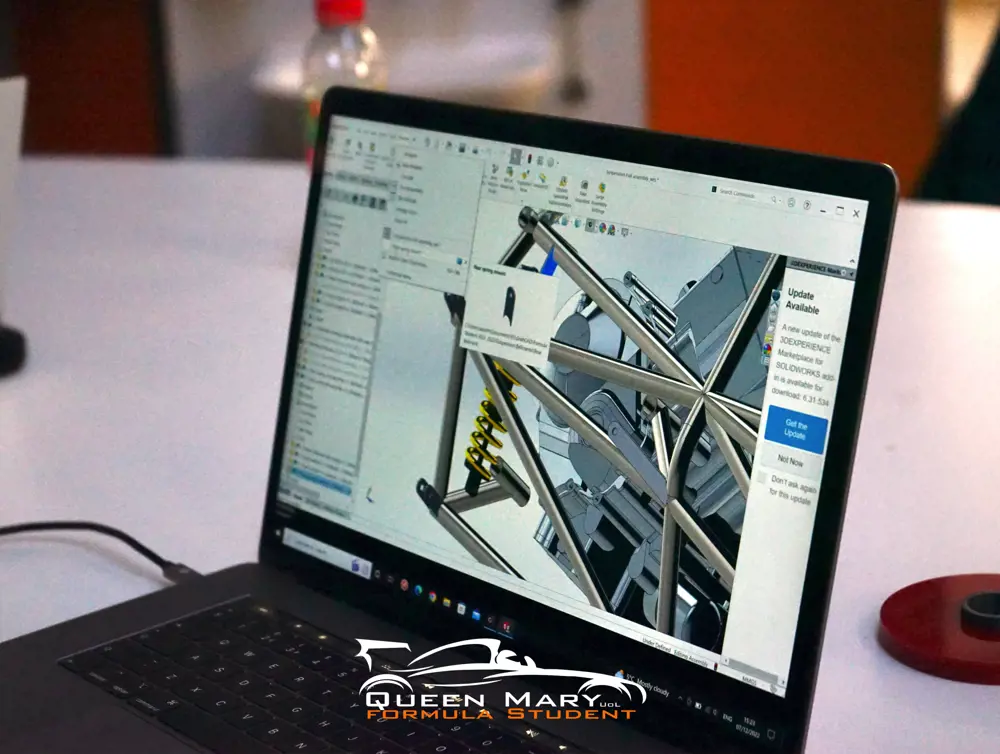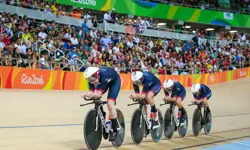
The road to Silverstone: preparing for Formula Student 2024
Who are we?
Behind the scenes of the Queen Mary team 👀
Since 2016, we have grown from a small group of dedicated students to a team of over 180, spanning multiple engineering and non-engineering disciplines. The nature of the competition is not only to build a race car but to educate university students in the act of justifying your choices, represented by the Design, Cost and Business events at the competition. Preparing students for future careers is the main goal, and luckily that comes in the form of building a race car.
Queen Mary Formula Student (QMFS) is a London-based student-run racing society at QMUL. Our aim is to design and build a single seater formula-style race car in preparation for the UK Formula Student competition, organised by the Institution of Mechanical Engineers.

The QMFS team at Silverstone 2023 © QMFS
Building a diverse team
QMFS is an incredibly diverse team, with students from 10 schools at QMUL contributing to the operation. We believe diverse teams make successful teams. So, we do our best to encourage students of all ages, gender identities, races, sexual orientations, physical or mental abilities, ethnicities, and perspectives to get involved. We are proud to be a team from one of the most diverse universities in the country and try to encourage this with our society activities. To encourage students from various degrees to try their hand at race car engineering, we have an entry-level program for new members. This takes them through the basics of computer-aided design (CAD), computer-aided engineering (CAE), prototyping and testing.
Our members work in cohesion to create an integrated vehicle design. This cohesion is created by communication, facilitated by student society leaders like Anastacia. She says: “Teamwork is encouraged and supported within the team by hosting weekly meetings amongst all team members for open discussions regarding designs, along with regular integration meetings where everyone is able to contribute to the design of the car collectively.”

Queen Mary’s 2023 model ready to race at Silverstone © QMFS
The sponsors making it happen
None of this would be possible without the help of our partners and sponsors. Our partners include the School of Engineering and Materials Science, who provide us with funding and space to work on the vehicle; The Queen Mary Students’ Union who facilitate our student recruitment and events via the society system; finally, Solidworks and Ansys provide us with professional software licences to complete our CAD and simulations.
We are in the process of reaching out to sponsors for this season, but as of May 2024 we would like to extend our thanks to Autoxross, Simpsons Race Exhausts, Geomiq, Laserlines, Schroth Racing, Easy Composites, Elite Electronic Systems, Explosive Apparel Designs, Accu and Hoosier for their support this competition season. Connecting with companies has been a huge part of the QMFS journey, and meeting professionals who are excited about racing is always a bonus when motorsport is your passion. The guidance and support provided has been invaluable from these connections. We would encourage any companies who are interested in supporting a competitive and motivated team to reach out to the team email or head over to our YouTube to see our introduction video for the 2024 season.
Aiming to become London’s best
Our team is rooted in competitive spirit and slowly, we are making progress to become the most successful London team at the Formula Student UK competition. In 2023 we competed with an IC Formula Class (a built car) and an EV Concept Class (a designed car). Overall, we placed 26th and eighth in these classes respectively. In the Formula Class we were the second-place university within London, and 18th in the UK. We did exceedingly well in the Cost & Manufacturing section of the competition, placing second overall out of 63 teams. Our EV team placed third in the UK in our first year designing for this vehicle architecture. While it may be a few years until you see a QMFS-EV car on track, the EV team are working even harder this year to secure a first place finish in concept.
This year we are determined to make Formula Student UK 2024 the most successful so far for the QMFS team. We have doubled down on documentation quality, designing to benchmarks and streamlining processes to produce better designs.
A recipe for coursework success: the best reasons to join a Formula Student team
Formula Student is an invaluable experience for aspiring motorsport engineers, due to the highly specific nature of the application. However, the team has found their time at Formula Student relatively harmonious with academia. The university is kind enough to allow creative coursework submissions, and team members often double up these submissions with required tasks for QMFS.

Computer-aided design of the suspension assembly © QMFS
The best example of this is the Computer Aided Engineering modules, where team members run high-quality simulations for stress analysis and computational fluid dynamics on car components. Other examples include materials selection, thermal analysis, systems design and design for manufacture.
Students can also organise to complete dissertations on the Formula Student vehicle. This year, we have had members evaluate the possibilities of 3D printing for components like front wings, wishbones and multimaterials for mounting. Our group of master’s students also designed a possible hybrid powertrain and drivetrain system, incorporating hub motors, advanced battery design and even energy recovery. Though you will most often find QMFS team members in the workshop, and not their lectures, you will also find them to be some of the hardest working engineers around.
We are grateful to FSUK and the IMechE for providing us the space to become more well-rounded engineers. Formula Student creates a place to meet like-minded people and personally, the years I’ve been involved in the team have been some of the best of my life so far. I am sad to be handing over the leadership of QMFS this July but if there’s something all Formula Student alumni can agree on, you never REALLY leave the team 🙂
Contributors
Cara Fox is a final year mechanical engineering student at Queen Mary University of London and Team Principal of QMFS, 2022 to 2024
Keep up-to-date with Ingenia for free
SubscribeRelated content
Sports & leisure

How technology enhances the Wimbledon tennis experience
The All England Lawn Tennis and Croquet Club (AELTC) and IBM worked closely together since 1990 to harness innovative technology to transform The Championships into one of the most popular and technically advanced events on the international sports calendar.

Noise-cancelling headphones
Used by plane and train passengers wanting to listen to radio, music or film without hearing background noises, active noise-cancelling (ANC) headphones are able to prevent outside noise from leaking through to the inside of headphones.

How to create the perfect wave
From small waves lapping at your feet and swells suitable for surfing to storm waves for testing structures and even tsunamis, waves of any shape and any size can now be engineered. What are the techniques and conditions needed to model waves and what makes some more powerful than others?

Going for gold
The success of Great Britain’s cycling team at the 2016 Rio Summer Olympic Games was celebrated, but what about the closely guarded technology that contributed to their success? The engineering approaches taken to shave as much time as possible off the clock are spoken about by Professor Tony Purnell.
Other content from Ingenia
Quick read

- Environment & sustainability
- Opinion
A young engineer’s perspective on the good, the bad and the ugly of COP27

- Environment & sustainability
- Issue 95
How do we pay for net zero technologies?
Quick read

- Transport
- Mechanical
- How I got here
Electrifying trains and STEMAZING outreach

- Civil & structural
- Environment & sustainability
- Issue 95